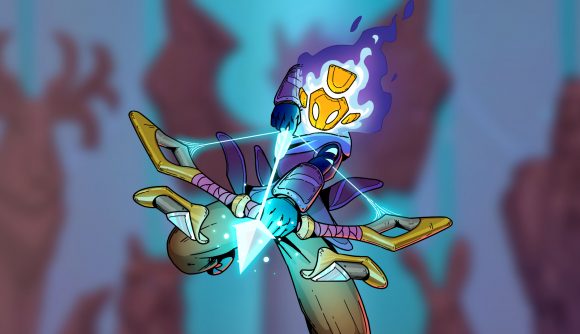Gentle Giant opens up on the making of its debut title Spiritfall and its unique combination of roguelike and platform fighter elements.

These days, the roguelike has famously managed to blend itself with other genres such as shooters, sidescrollers, and isometric dungeon crawlers. Rather than fall into one of those three categories, Gentle Giant’s Spiritfall instead draws influence from platform fighters, of all things.
Like in Super Smash Bros. Ultimate or MultiVersus, Spiritfall has players fighting enemies on a 2D plane and jumping between different floors on a stage.
I played two of Spiritfall’s three beta versions that closed out 2022, and as someone who hasn’t spent much (or any) time with the platform fighter genre, I found Spiritfall’s mechanics easy to wrap my head around.
It turns out combining that style of gameplay with roguelikes conventions works surprisingly well, and it’s one of those blends I didn’t realize I’d like until I got it in my hands. After grabbing one of three weapons, everything clicked right away as I practiced on some training dummies.
But it also helps that Spiritfall has elements of Supergiant’s Hades in its gameplay, as players receive blessings from animal gods that manifest as elemental powers. The verticality of its stages and the chaotic nature of platform fighters meant fights could be scrappier than in Hades, but it was still satisfying to clear a stage with abilities like freeze bombs and dashing to create a flaming bird.
Ahead of its recent Steam Next Fest demo and Early Access release in March, I spoke with Gentle Giant about its debut title, including how it settled on the game’s blend of different mechanics, its structure as a roguelike, and its various sources of inspiration.

Q: When it came to figuring out what Spiritfall was going to be, which came first: the sidescroller roguelike or the platform brawler? Which was easier to start with?
We started with a more vague idea of what Spiritfall should be like, trying to take the best aspects of certain games that we enjoyed and thought could work well together. It was definitely more hack-and-slashy at the earlier stages because we tried to remove some Platform Fighter mechanics. We feared it would make the game less accessible for more casual players.
Eventually, it became clear that we had to lean into the mechanical depth of platform fighters much more, there is a reason why they are there. The challenge became identifying what mechanics better fit both the single-player experience and also the added layer of roguelike randomness. It took a bit of time and a few iterations but we have managed to become much closer to our initial goal, which is having enough depth for more hardcore players while keeping the game welcoming for newcomers. We think that once we add more content and flexibility on top of the foundations we’ve made so far, the game will truly shine.
Q: It's easy to see the platform fighter influences, but what other roguelikes or sidescrollers served as inspiration?
When it comes to roguelikes, one of the clearer influences is Hades. We felt that the way [Supergiant] grouped various power-ups into more predictable "pools" was very compelling in a game with many random factors.
We also think [Hades’] approach to small combat spaces as opposed to larger sprawling levels fits well with our focus on fast-paced action. Games with a map that allow you to make quick but long-term decisions also come to mind, like Slay the Spire or FTL. There is also inspiration from other games outside of the roguelike umbrella, such as Hollow Knight and Maple Story.
We have played a lot of roguelikes, and it's difficult to pinpoint where a certain idea originates from, so the approach was that a mechanic was worth examining if it complimented our combat system and other mechanics.
Q: Spiritfall has three weapons—the hammer, the bow, and the fists. How'd you settle on that as your golden trio, and what were some of the other weapons under heavy consideration before being cut?
Spiritfall's weapons were designed around play styles we wanted to explore. The Battle Hammer-Axe is a heavy hitter, while the Sisterhood Gauntlets are much faster, and then we have the bow as a ranged weapon. Each weapon being so different helped feed into the balancing of the game, as we tested how each weapon changed your approach to different rooms and enemies.
No weapons have been cut, there's just weapons we haven't implemented yet.

Q: What is the culture that’s come to inspire the game, and how did that reflect the way you tweaked them to a particular element/play style?
From a visual perspective, we took inspiration from various cultures when crafting the fantasy world of Spiritfall, drawing the most influence from Asian and Middle-Eastern designs and architecture.
We wanted Spiritfall to feel mysterious, you enter this world without much context and have to figure out its lore and past on your own. The language of the characters, the names of the spirits, and the spiritual and religious parallels all try to invoke the sense of something familiar yet unknown.
Another aspect of culture that is important to us as developers is that of the game's genre and its players. It is quite challenging to mix genres, you need to know what compliments the other and how to keep different kinds of players satisfied with the gameplay. We are doing our best to include depth that fighting game fans can appreciate, but also be inviting to newcomers or those who are more on the roguelike side of things.
Q: Some roguelikes indicate the reward that awaits in the next room, but Spiritfall doesn’t just show what’s next, it also outlines the path(s) players can take before they reach the boss. What was your thinking into giving players a pretty clear map for the region?
We wanted to add more depth to the way you plan out your in-run progression. Some roguelikes tend to focus on the moment-to-moment decisions by only showing you the next available room rewards. That can work great, but we felt that it left something to be desired for people who enjoy the route management aspect. Especially when it comes to making a choice that has multiple other choices attached to it.
We also didn't want the map to be overbearing, and the pace of engaging with it to be rather quick. A big influence on our decision to implement our take on the map was Inscryption, which had interesting map choices while keeping it simple, we felt like we could try something similar.
Q: The December update contained challenge rooms with monsters, and that’s where you really feel the game’s platform fighter influence come through. What went into creating those?
When we approached the genres of roguelikes and platform fighters, we recognized there were some points of tension we would need to resolve.
Initially, we examined the approach of being able to ring-out enemies and kill them early, which is an exciting occurrence in platform fighters but doesn't work as well for a single-player roguelike game. In Spiritfall, the increased knockback instead integrates mainly into our wall-splat and bounce mechanic, allowing you to extend or create new combos and stun-lock the enemy for big damage.
Still, we felt like we wanted to bring the ring-out mechanic into the game as it is such a core pillar of the platform fighter genre. We found a balance with these encounters that increase the pressure difficulty-wise but also reward you more for pulling through successfully. Pulling it together was a really fun challenge.
What a year! Check out this first look at our super early gameplay prototype next to footage from our latest Beta, the game has come a long way.
— Spiritfall | Wishlist on Steam (@gentlegiantgms) December 27, 2022
Thanks to all of you who supported us with our little indie roguelike platform fighter, see you in 2023! pic.twitter.com/6luglpEnwP
Q: How much has Spiritfall changed from its first beta up to this Next Fest demo release? What surprised you about how beta players reacted to the successive changes made from then to now?
Spiritfall has definitely evolved a lot since our first beta as we have added new features, enemies, weapons, and also mechanics like hit-stun. But it has all kept to our core vision for the game. The feedback from beta players was great so we were more surprised by the support itself!
We QA as much as possible internally, but the beta community helped us catch some key issues. We're confident going into Early Access that we have a strong core at the heart of the game.
About the Author(s)
You May Also Like









